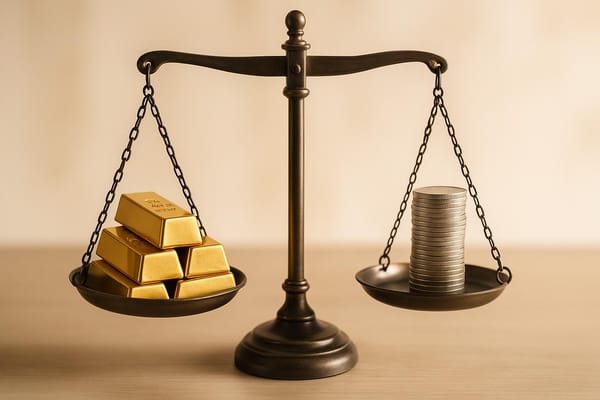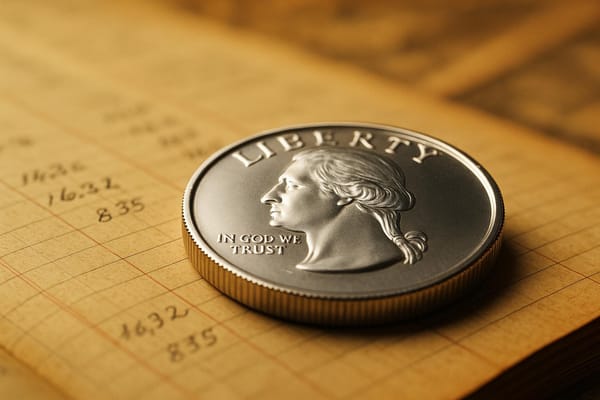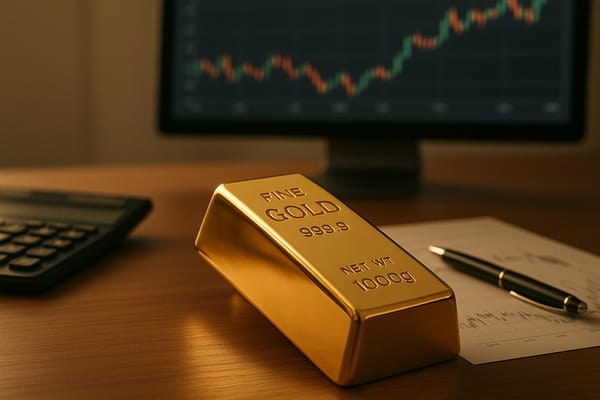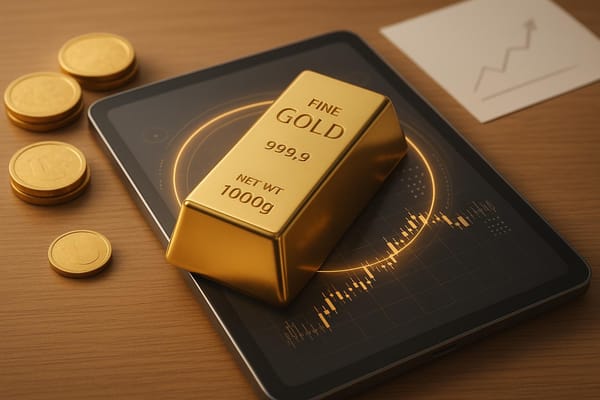Gold vs Silver: Which Metal to Invest In?
Explore the distinct characteristics, risks, and investment potential of gold and silver to make informed choices for your portfolio.
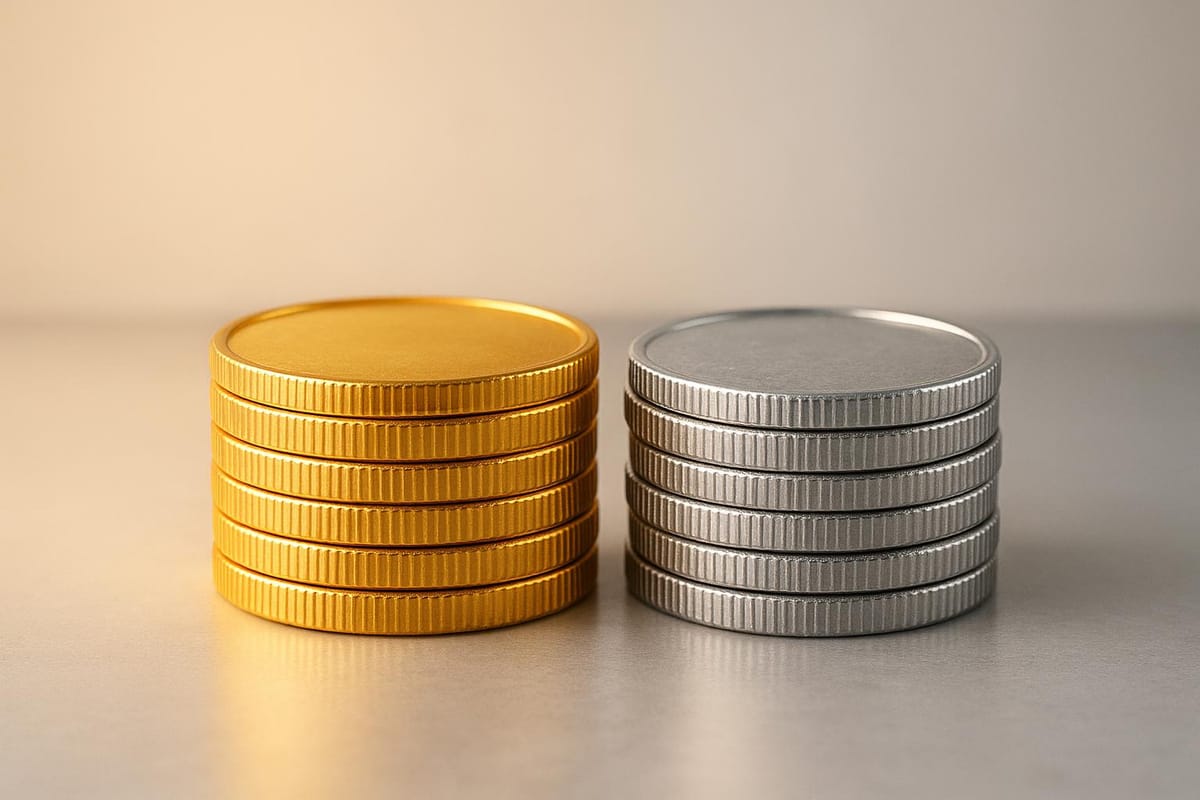
Looking to diversify your portfolio with precious metals? Here's the quick answer:
- Gold is the go-to for stability and long-term wealth preservation. Its price is less volatile, and it’s a strong hedge during economic uncertainty. Current price: ~$3,336 per ounce.
- Silver offers higher growth potential but comes with more price swings. It’s cheaper to start with and benefits from rising industrial demand. Current price: ~$36 per ounce.
Key Differences:
- Market Behavior: Gold is stable and driven by investment demand. Silver is more volatile, influenced by industrial use.
- Affordability: Silver is more accessible for new investors due to its lower price.
- Risk: Gold has lower volatility; silver’s price can swing 2–3x more.
- Demand Drivers: Gold is a safe haven; silver is essential for industries like solar energy and EVs.
Quick Comparison Table:
| Criteria | Gold | Silver |
|---|---|---|
| Price (June 2025) | ~$3,336/oz | ~$36/oz |
| Volatility | Lower | Higher |
| Primary Use | Wealth preservation | Industrial + investment |
| Demand Drivers | Central banks, investors | Solar, EVs, industrial use |
| Accessibility | Higher cost per ounce | Lower cost per ounce |
Investment Tip:
- Conservative investors: Focus on gold for stability.
- Aggressive investors: Tap into silver for potential higher returns.
Both metals can play unique roles in your portfolio. Let’s dive deeper into their differences and how to choose the right one for your goals.
GOLD or SILVER in 2025; Which Should You Be Stacking?
Gold vs Silver: Main Differences
Understanding the differences between gold and silver is essential for making informed investment decisions. These two metals behave differently in financial markets, have varying price points, and serve distinct roles in both investment portfolios and industrial applications.
Market Behavior and Pricing
Gold and silver differ significantly in terms of pricing and market behavior. As of June 2025, gold is trading at around $3,336.55 per ounce, while silver is priced at approximately $36.30 per ounce. This price gap makes silver a more accessible entry point for new investors looking to diversify with precious metals.
Gold is widely regarded as a "safe-haven" asset, offering stability during economic uncertainty. In contrast, silver - being cheaper and heavily influenced by industrial demand - tends to exhibit more price volatility. For example, silver has surged nearly 25% year-to-date, with spot prices hitting $36.30 per ounce on June 6, 2025, marking its highest level in over 13 years. Meanwhile, gold has benefited from consistent safe-haven demand, driven by ongoing geopolitical tensions and weak U.S. economic indicators.
"Gold offers stability; silver has significantly higher growth potential due to its lower price point and industrial demand dynamics." - Clive Thompson, Wall Street Bullion
The factors influencing these prices also differ. Gold's value is primarily shaped by investment demand and central bank purchases. Central banks, for instance, are on track for their fourth consecutive year of substantial gold acquisitions. On the other hand, silver plays a dual role as both a monetary asset and an industrial metal. This is evident in its market behavior; in June 2025 alone, silver-backed exchange-traded funds recorded inflows of 2.2 million ounces in a single day.
These dynamics highlight the importance of the gold-silver ratio as a key metric for market analysis.
Gold-Silver Ratio Explained
The gold-silver ratio measures how many ounces of silver are needed to purchase one ounce of gold. Currently, this ratio stands at 97:1. Historically, when both metals were used as currency, the ratio averaged around 15:1. In more recent times, it has typically ranged between 50:1 and 80:1. However, during periods of market stress, the ratio can shift dramatically - such as the near 100:1 ratio during the 2020 market turbulence or the sharp compression to 17:1 during the 1980 precious metals boom.
Investors often use this ratio to guide their strategies. A high ratio suggests that silver may be undervalued compared to gold, prompting some to add silver to their portfolios. Conversely, a low ratio might indicate a better opportunity to focus on gold. Some investors even rebalance their holdings by switching between the two metals as the ratio fluctuates.
Beyond market ratios, the industrial applications of these metals further distinguish their value.
Value Sources and Industrial Uses
Gold and silver derive their value from different sources. Gold is primarily seen as a financial asset and a hedge against economic instability. About 50% of its annual consumption is tied to jewelry, while its role as a safe haven underpins its demand during periods of currency debasement and financial uncertainty.
Silver, however, stands out for its strong industrial demand. Over 50% of silver's production is used in industrial applications. In 2023, industrial consumption of silver hit a record 654.4 million ounces. The push for green energy has further amplified silver's importance. For instance, photovoltaic technology accounted for 193.5 million ounces of silver in 2023, while electric vehicles typically use 25 to 50 grams of silver, and hybrid vehicles require 18 to 34 grams.
"The deficit between industrial demand and mine supply is getting larger each quarter. Recycled silver initially filled this gap, but dealer inflows are now reduced to a trickle despite the price incentives." - Clive Thompson, Wall Street Bullion
This growing industrial demand has made silver more sensitive to shifts in global manufacturing and economic activity. Since 2021, the silver market has faced consistent undersupply, with a 184-million-ounce deficit recorded in 2023. The Silver Institute predicts that demand will continue to outpace supply this year. Silver's exceptional electrical and thermal conductivity, along with its malleability and resistance to corrosion, makes it indispensable across various industries, including solar panels, automotive manufacturing, and medical devices.
For investors, these distinctions are key. Gold offers more stable and consistent demand, while silver's reliance on industrial applications makes it more susceptible to economic fluctuations. As a result, during periods of slowed manufacturing, silver prices often experience sharper declines compared to gold.
Performance Comparison: Gold vs Silver
Taking a closer look at how gold and silver have performed historically reveals some interesting contrasts in returns and risk. This kind of analysis can help investors make informed decisions about where to allocate their resources.
Long-Term Returns
Over the past ten years, gold has delivered an annualized return of 7.7%, outpacing silver, which posted a 6.08% return during the same period. Looking at a broader timeframe, gold's 15-year annualized return of 4.9% has also consistently surpassed silver's performance.
However, silver has occasionally shown remarkable growth during specific market conditions. For instance, during the Great Financial Crisis and the European Debt Crisis, silver skyrocketed by 495%, while gold rose by 238%. More recently, in 2025, gold gained about 29%, while silver increased by 24%. During that same year, traditional equity markets struggled, with the S&P 500 Index dropping 9.42% year-to-date. In contrast, gold and silver posted gains of 17.29% and 3.1%, respectively. Gold's performance further shines when compared to historical recessions, as it outperformed the S&P 500 in six of the eight U.S. recessions between 1973 and 2020.
"We have been expecting silver to close its performance gap with gold for some time. The metal has firm fundamentals, including being in a supply deficit and industrial demand being robust." – Nitesh Shah, commodities strategist at WisdomTree
Next, let’s dive into their price movements and risk levels to understand these differences better.
Price Swings and Risk Levels
When it comes to volatility, gold and silver tell two very different stories. Gold has an average volatility of 16.2%, while silver's is significantly higher at 28.8%, making silver a much riskier investment. Since April 1968, gold has been more volatile than silver less than 9% of the time.
Silver's volatility stands out even more when compared to broader market indices. Historically, silver has been more volatile than the S&P 500 Index nearly 90% of the time (89.1%), while gold has been less volatile than the S&P 500 almost two-thirds of the time. Additionally, silver tends to exhibit about 1.5 times the volatility of gold in response to U.S. dollar fluctuations. This heightened volatility is partly due to silver's dual role as both a hedge against economic instability and a key industrial material.
"Silver's dual role creates volatility – it's a hedge against instability but suffers in manufacturing downturns." – Ramos Veracadar, ICICI Securities
In fact, silver's price swings can be two to three times greater than gold's, underscoring the higher level of risk involved in investing in silver.
Which Metal Fits Different Investors
Choosing between gold and silver often comes down to an investor's goals, risk appetite, and investment timeline. Gold is a popular choice for those seeking stability and long-term wealth preservation, while silver may attract investors who are comfortable with higher risk in exchange for the potential of greater returns.
Gold is also highly valued for its ability to diversify portfolios. Its lack of correlation with stocks makes it an effective tool for reducing overall portfolio risk. As a safe-haven asset, it plays a crucial role in protecting wealth during economic uncertainty.
Silver, on the other hand, is more accessible to small investors due to its lower cost. With silver priced around $34 per ounce compared to gold's $3,300 per ounce, new investors can build meaningful positions without a large initial outlay. Additionally, silver's significant use in industrial and technological applications provides extra demand drivers that could fuel its growth.
"In the long-term, rising demand for silver as an industrial material means prices could reach $40 or even $50 per ounce." – Fawad Razaqzada, market analyst at City Index and FOREX.com
For those looking for quicker gains, silver’s higher volatility can create opportunities during favorable market conditions. However, this requires careful timing and risk management. Meanwhile, gold's steadiness makes it a reliable choice for diversification and long-term capital preservation.
These insights provide a solid foundation for exploring the factors that influence investment decisions in these metals.
Key Factors When Choosing Gold or Silver
When deciding between gold and silver for your investment portfolio, it’s not just about performance or market volatility. Practical factors like cost, accessibility, and market demand can significantly influence your strategy. Let’s break down what you need to know.
Cost and Accessibility
The price difference between gold and silver is striking. As of June 9, 2025, Monex Spot Gold is priced at $3,316.00 per ounce, while Monex Spot Silver comes in at just $36.27 per ounce. This means a $1,000 investment would get you roughly 0.3 ounces of gold but a much heftier 27 ounces of silver. Clearly, silver is more accessible for entry-level investors.
However, silver’s affordability comes with a trade-off: storage challenges. Since silver is less dense, storing the same dollar value of silver requires far more space than gold. On top of that, buying physical metals often involves premiums above spot prices. For instance, a 1-ounce Gold Bullion Bar might have a bid price of $3,261.00 and an ask price of $3,391.00. The gold-to-silver price ratio currently sits at around 70:1, further highlighting silver’s cost advantage for smaller investors.
Understanding these cost dynamics is just the first step. To make an informed choice, it’s crucial to explore what drives demand for each metal.
What Drives Demand for Each Metal
Gold and silver are influenced by entirely different market forces. Gold is primarily valued for its role as a safe-haven asset and a monetary standard. Central banks, particularly in BRICS nations, are major players in the gold market. These countries collectively accumulate around 1,000 tonnes of gold annually, with nations east of Germany significantly increasing their reserves as they seek alternatives to dollar-based systems.
"Gold's drivers are definitely not happening out of the West…it's sovereign wealth funds and central banks." – Christopher Aaron
Silver, on the other hand, is heavily tied to industrial use. Around 83% of annual silver production goes toward industrial applications. Its exceptional electrical conductivity makes it essential for modern technology. In 2024, global silver demand hit 1.2 billion ounces, with the photovoltaic solar industry being a key driver. In fact, solar panels now account for about 20% of global silver consumption, and industrial use surged by 7% to 700 million ounces that same year.
"Anything that has an on-or-off switch needs silver." – Michael DiRienzo, President and CEO of The Silver Institute
Unlike gold, silver doesn’t see much interest from sovereign buyers. This makes its price more dependent on industrial demand and retail investor sentiment. The silver market has faced consistent supply deficits since 2021, with 2023 alone recording a shortfall of 184.3 million ounces.
"We are in a four-year deficit of around 240 million ounces (annually) and it's climbing every single year." – Keith Neumeyer, CEO of First Majestic Silver
These distinct demand drivers highlight the unique roles gold and silver can play in diversifying your investment portfolio.
Price Forecasts
Looking ahead, price forecasts for gold and silver reflect their differing market dynamics. Silver, in particular, is expected to see strong gains in 2025. Institutions like Citigroup and Saxo Bank predict silver prices could reach around $40 per ounce, while JP Morgan estimates $38. Alan Hibbard, GoldSilver’s Lead Analyst, shared his perspective:
"I'm expecting silver to return about 25% in 2025, putting it around $40. And I'm expecting 2026 to be the year that silver reaches an ATH above $52.50."
Some forecasts are even more optimistic. InvestingHaven suggests silver could climb to $48.20–$50.25 per ounce, with potential peaks as high as $80. Industrial demand for silver is expected to grow by 3% in 2025, with investment demand projected to rise similarly.
Gold, while less volatile, remains a strong investment. With prices at $3,350 per ounce as of June 6, 2025, continued central bank buying and geopolitical tensions are likely to support its value. However, its higher price point limits potential percentage gains compared to silver.
Investors should keep an eye on factors like central bank policies, geopolitical shifts, and supply dynamics. For silver, industrial adoption - particularly in solar energy and electric vehicles - will be especially critical. Staying adaptable and monitoring market trends can help you navigate the unique movements of gold and silver prices.
Conclusion: Picking the Right Metal for Your Portfolio
Deciding between gold and silver comes down to your financial goals, how much risk you're comfortable with, and your investment timeline. Each metal brings its own strengths and can fit into different strategies.
Key Takeaways
Gold is known for its stability and ability to diversify portfolios. As of March 2025, it trades around $3,097 per ounce and has delivered average annual returns of 7.98% from 1971 to 2024. It’s also largely uncorrelated with stocks, making it a reliable diversifier.
Silver, on the other hand, offers greater potential returns but comes with significantly more volatility. Its price can fluctuate two to three times more than gold on any given day. This makes it a riskier option but one with higher reward potential, especially for smaller investors due to its lower price point.
Gold and silver also serve different roles in a portfolio. Gold often acts as a safe haven, moving inversely to the stock market. Silver, with over 50% of its global demand tied to industrial uses, tends to follow broader economic trends. Because of its smaller market size, even minor changes in investment demand can lead to significant price swings.
Understanding these dynamics can help you make more informed decisions about how to include these metals in your investment strategy.
Investment Guidelines
Your allocation to gold and silver should align with your financial goals and risk appetite. Here are some general recommendations:
- Conservative investors: Consider 8–10% in gold and 2–3% in silver.
- Balanced investors: Aim for 5–8% in gold and 3–5% in silver.
- Aggressive investors: Allocate 7–10% to silver and 3–5% to gold.
"Silver's lower price point makes it easier for investors to adjust positions based on market conditions, providing greater flexibility in portfolio management." – Morgan Stanley
Timing is another critical factor. Gold tends to perform well during periods of economic uncertainty or high inflation, while silver often shines during economic growth or downturns. However, silver might not be the best choice during significant economic slowdowns.
Currently, the market offers intriguing opportunities. With ongoing silver supply deficits and predictions of prices reaching $40–50 per ounce by the end of 2025, silver could attract tactical investors. Meanwhile, gold continues to hold its ground as a safe haven, especially given persistent geopolitical tensions.
FAQs
What is the gold-silver ratio, and how does it influence investment decisions?
The gold-silver ratio tells us how many ounces of silver you’d need to buy a single ounce of gold. It’s a handy tool for anyone investing in precious metals, offering insights into potential market trends.
When this ratio is high, it suggests gold is pricier compared to silver, hinting that silver might be undervalued. Conversely, a low ratio could mean gold is the better deal. Investors often rely on this ratio to decide whether to buy or sell, especially during periods of economic instability when precious metals are seen as safer investments.
For instance, if the ratio jumps to 100:1, it might indicate that silver prices could rise soon, as such spikes have historically been followed by market adjustments. Keeping an eye on this ratio can help shape smarter investment strategies.
What drives silver's industrial demand, and how could it impact its price in the future?
Silver plays a critical role in renewable energy technologies like photovoltaic (PV) solar panels and in the expanding market for electric vehicles (EVs), including their charging systems. Thanks to its exceptional conductivity and efficiency, silver has become a key material in these rapidly growing industries.
Industrial demand for silver has been climbing steadily. By 2024, its usage is expected to hit around 700 million ounces, with further increases anticipated as electrification trends gain momentum. At the same time, the market faces a supply shortfall of roughly 240 million ounces per year, creating a scenario where demand outpaces supply. This imbalance has the potential to drive silver prices up, possibly reaching $40 to $50 per ounce in the near future. These dynamics make silver an intriguing option for those considering long-term investments.
Why do some investors choose to include both gold and silver in their portfolios instead of focusing on just one?
Including gold and silver in a portfolio can provide a well-rounded approach to investing, as each metal brings its own advantages to the table. Gold is often viewed as a safe haven, offering a sense of security during times of economic instability and acting as a hedge against inflation. Meanwhile, silver tends to be more unpredictable but benefits from strong industrial applications, particularly in areas like technology and renewable energy, which can fuel growth during periods of economic expansion.
Combining gold's steady nature with silver's growth potential allows investors to create a more balanced portfolio. This strategy not only helps reduce risk but also positions the portfolio for stronger performance over the long term, even in shifting market conditions.
